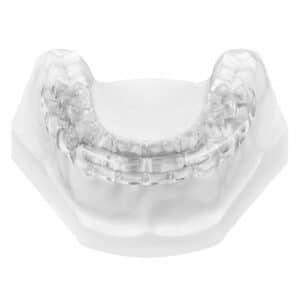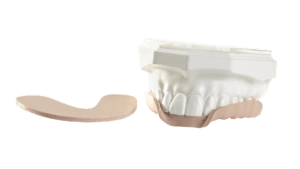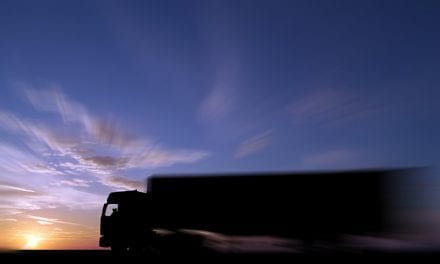Advances in materials and technology mean oral appliance users have every opportunity to get their original bites back.
By Chaunie Brusie, RN, BSN
For individuals who utilize oral appliance therapy to treat their obstructive sleep apnea, unwanted side effects can range from annoying to severe.
Fortunately, morning repositioner devices, also known as morning occlusal guides or morning aligners, can help reverse side effects. And thanks to technology that can keep a digital record of a patient’s bite, those devices are becoming more accessible, precise, and accurate than ever.
Side Effects of Oral Appliance Therapy

Mark T. Murphy, DDS, DABDSM, lead faculty, clinical education, at oral appliance maker ProSomnus Sleep Technologies, says there are four main types of side effects that patients may experience from oral appliance therapy: dry mouth and excessive salivation, sore muscles, tooth movement, and jaw position changes.
Some of the side effects can be solved pretty simply, such as keeping the lips together to reduce dry mouth or stretching achy muscles, says Murphy, who practices dental sleep medicine at Funktional Sleep in Rochester Hills, Mich. But tooth and jaw movement can be both more worrisome to patients that experience them, as well as require a step up in intervention to remedy. Tooth movement, in particular, Murphy says, can be quite distressing for some people, especially if it changes the appearance of their smile.
The fourth side effect is a posterior open bite development as a result of the jaw displacement caused by oral appliance therapy. Murphy explains that the posterior open bite is transient but can become permanent if it’s not reversed every day. The jaw displacement occurs as a result of the action of the jaw being pulled forward during sleep through an oral appliance will lead to an accumulation of fluid in the jaw joints. “That’s perfectly normal,” he says. “It’s going to happen to any joint when you displace it like that for a period of time.”
When fluid accumulation occurs in other joints in the body, such as a hip or a shoulder, the person may wake up feeling stiff but would quickly stretch it out, start moving, and go about the day—allowing the fluid to displace and the symptoms to dissipate without much thought. But when the fluid accumulation happens in the jaw joints, it’s much more noticeable to patients because even a little fluid displacement means when the individual bites together in the morning, their front teeth touch and their back teeth don’t touch.
“It’s kind of weird to get up in the morning and say, ‘Hey, my bite changed,’” Murphy says. While it’s possible to displace the fluid in the jaw just like it is in other parts of the body, he adds that it can be easy to overlook the daily work needed to overcome the bite change. For some people, that could result in the bite change becoming permanent. And while even a permanent bite change wouldn’t be dangerous—“The airway is more important than the perfect bite,” Murphy says—it is a change that’s easily preventable.
And that’s where morning repositioners come in. As the name implies, morning repositioners are tools that help the patient using oral appliance therapy to “reposition” their jaw back to normal in the morning. “There really isn’t any reason to not get your bite back,” Murphy says.
Morning Repositioners: They’ve Come a Long Way

In 1996, Keith Thornton, DDS, inventor of the TAP (Thornton Adjustable Positioner) oral appliances, documented a temporary bite change in almost all of a cohort of 300 oral appliance users. The bite change lasted about 15 to 30 minutes after oral appliance removal. He also noted a permanent posterior open bite in 9 of the patients within the first 6 months of wear.1
Thornton had also already come up with a solution: a morning repositioner. “The initial ones were bite tabs made from football mouthguard material,” he remembers. Since then, Airway Management Inc, an oral appliance maker at which Thornton is chief technology officer and chairman of the board, has developed numerous iterations of morning repositioners, including the present AM Aligner.
The AM Aligner, which Thornton also helped design and bring into fruition, is a dental device that helps restore the bite to the original position and requires only a little hot water. “I think this is one of my best contributions to the profession,” he says.
Thornton, who practices dental sleep medicine at SleepWell Solutions in Dallas, Texas, says, “The most important feature of the repositioner is to duplicate the position that the patient’s teeth touch under heavy biting pressure. This requires an extremely thin layer in the contact areas. Plus, the material must be very resilient and tough. When biting hard on the device the patient should feel only their back teeth.” He adds that he considers morning repositioners to be an essential component of oral appliance therapy.
Repositioning Goes Digital
Digital technology is also reframing the landscape for morning respositioners. ProSomnus’ Murphy, along with Shandra Rosenfeldt, DDS, presented a poster at World Sleep 2022 that demonstrated the ability to make a morning repositioner from just the patient’s digital records.2
The story behind the experience, Murphy says, is an interesting one—it was spurred one when a patient accidentally left his morning device out on the dashboard of his car, where it proceeded to melt into a blob. Without daily use of the repositioner, the patient’s bite shifted, which made taking measurements a challenge. However, Murphy was able to take the old models that had been digitized and recreate a morning occlusal guide from the original measurements.
The new precision-milled device that Murphy created, along with recommended exercises, was successful in recapturing the patient’s bite. And of course, just to be safe, Murphy made sure to include a back-up morning repositioner as well. “I gave him two of those,” he says. “Now he uses those things every single morning.”
Murphy sees the ability of having original measurements, no matter what later changes may happen to the mouth and teeth, as a primary advantage of digital record technology.
“Having these digital records allows us to manipulate the digital records and put the two upper and lower models to two models of the upper and lower jaw together in what we see, think, and feel is the ideal bite relationship,” he says. “If the patient had lost their bite and we didn’t have visual records that we could work off, we’d have a tougher time trying to replicate the original bite.”
Like other devices, especially those made out of thermoplastic material, morning repositioners can wear out over time, or, as already demonstrated, melt on car dashboards. Plus, man’s best friend loves to chew on devices like these, which dogs presumably see as tasty, saliva-filled chew toys, Murphy adds. But with digital technology, instead of a patient needing to start the entire measurement and fitting process all over again, “we literally just press a button and make a new one,” he says.
While there are certainly challenges—individuals with advanced periodontitis or missing teeth, for instance, may require more focused measurements—Murphy says that if it’s possible to create an oral appliance for someone, then it’s possible to make them a morning occlusal guide too.
“Precision oral appliance therapy is really kind of taking over now in sleep medicine,” says Murphy. “And I think we’re going to see that same kind of emphasis carry through to precision MOGs [morning occlusal guides] because we have the technology today to be able to do this at a very high level.” He compares precision repositioner and oral appliance therapy to the same level of precision-focused care one might get from other medical procedures—whenever possible, the standard of care is minimally invasive, precise, and personalized.
“There’s a precision that occurs in medical treatments today for chronic disease management that is changing the way we treat patients,” he says.
TOP IMAGE: A dentist shows posterior contact in a ProSomnus morning repositioner. Photo courtesy of John Carollo, DMD
Chaunie Brusie, RN, BSN, is a content creator specializing in health, medical, parenting, finance, and travel.
References
1. Thornton WK, Roberts DH. Nonsurgical management of the obstructive sleep apnea patient. J Oral Maxillofac Surg. 1996 Sep;54(9):1103-8.
2. Murphy M, Rosenfeldt S. Recapturing a posterior open bite using a precision milled morning occlusal guide. World Sleep 2022:Poster#070.





